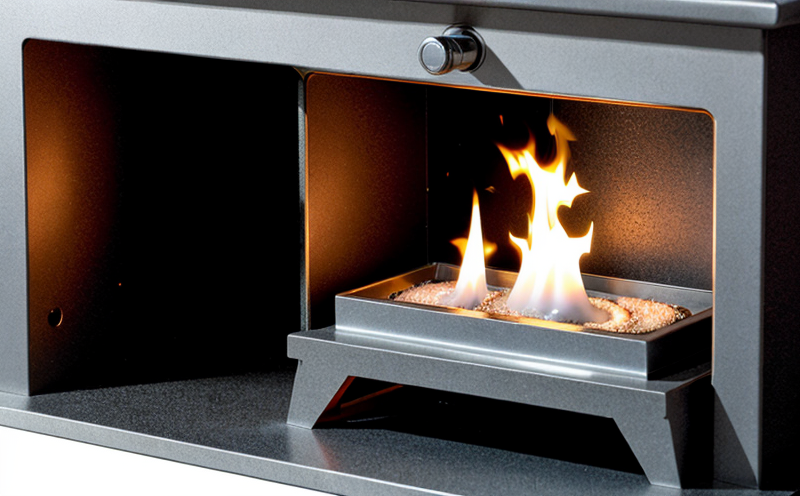ASTM E84 Surface Flame Spread Testing
The ASTM E84 method of testing is a fundamental standard used to assess the surface flame spread and ignitability characteristics of building materials. This test is particularly important in fire safety assessments, ensuring that materials meet regulatory requirements for reducing fire hazards within buildings.
ASTM E84 employs two key indices: Smoke Developed Index (SDI) and Flame Spread Index (FSI). These indices provide a quantitative measure of the material's behavior when exposed to an ignition source. The FSI ranges from 0 to 100, with lower values indicating better fire resistance. Similarly, SDI measures smoke production ranging from 0 to 450, where higher numbers indicate greater amounts of smoke produced during combustion.
The test involves placing a sample under standardized conditions within a specially designed tunnel furnace. An ignition source is applied at one end, and the behavior of the flame spread and smoke generation are recorded using photometric sensors and observation windows. This method ensures consistent results across various materials, making it a reliable tool for quality assurance.
The ASTM E84 test is widely used in construction industries to ensure that materials comply with fire safety standards set by local authorities and international bodies. It helps architects, engineers, and building owners make informed decisions about the use of flame-resistant materials, ultimately contributing to safer environments.
In real-world applications, this testing plays a crucial role in various sectors including residential construction, commercial buildings, and industrial facilities. Compliance with ASTM E84 ensures that structures are less likely to spread fire rapidly, thus protecting lives and property. Additionally, the test contributes to sustainable building practices by promoting the use of safer materials.
The apparatus used for ASTM E84 testing includes a tunnel furnace, photometric sensors, a calorimeter, and other specialized equipment. These tools are calibrated regularly to ensure accurate measurements. The sample preparation process involves cutting specimens into standard sizes, ensuring uniformity across tests.
Once prepared, the samples are placed in the tunnel furnace where they are subjected to controlled conditions. The ignition source is applied, and data on flame spread and smoke production is captured over a specified period. This detailed data is then analyzed to determine compliance with ASTM E84 standards. Compliance is critical for manufacturers aiming to meet regulatory requirements and gain market access.
The results of the test are crucial for quality managers and compliance officers as they provide actionable insights into material performance. R&D engineers use these findings to refine formulations, while procurement teams rely on them to select compliant suppliers. The comprehensive nature of ASTM E84 testing ensures that materials not only meet current standards but also contribute positively to fire safety.
Applied Standards
| Standard | Description |
|---|---|
| ASTM E84-21a | This standard specifies a method for determining the surface flame spread and smoke developed ratings of building materials using a tunnel furnace. |
| EN 13501-1:2011 | An equivalent European standard that provides requirements for the classification of construction products with respect to fire performance. |
| ISO 8613-2 | This ISO standard outlines methods for determining surface flame spread and smoke developed indices using a tunnel furnace. |
| BS 476-7:2019 | The British equivalent that specifies the procedure for assessing the surface burning behavior of materials. |
| IEC 60332-1 | This standard sets requirements for the ignition resistance of insulated wiring and cable assemblies, which can be relevant in certain fire safety contexts. |
Quality and Reliability Assurance
The quality and reliability of ASTM E84 testing are paramount for ensuring consistent results across different laboratories. Rigorous calibration procedures, adherence to standard operating procedures (SOPs), and regular maintenance of equipment guarantee accurate measurements. Quality managers play a crucial role in overseeing these processes to maintain the integrity of test results.
Compliance officers must ensure that all testing aligns with current standards and regulations. This includes staying updated on any revisions or updates to ASTM E84, which can affect compliance requirements for building materials. By doing so, they help prevent non-compliant products from entering the market, thus protecting public safety.
R&D engineers benefit greatly from reliable test data as it informs their research and development efforts. Accurate ASTM E84 results allow them to make informed decisions about material composition and design improvements, ultimately leading to safer and more efficient building materials. The use of standardized testing methods ensures that findings are replicable across different laboratories.
Procurement teams rely on the reliability of these tests when selecting suppliers for their projects. By ensuring that only compliant materials are used, they contribute to the overall safety and compliance of construction projects. This not only meets regulatory requirements but also enhances the reputation of the organization involved in the project.
Environmental and Sustainability Contributions
The ASTM E84 testing process contributes positively to environmental sustainability by promoting the use of materials that are inherently safer and more resistant to fire. This reduces the risk of fire-related incidents, which can have significant environmental impacts such as loss of life, property damage, and increased carbon emissions from rebuilding efforts.
By ensuring compliance with ASTM E84 standards, construction projects can achieve higher ratings on sustainability metrics, thereby attracting environmentally conscious clients and stakeholders. This aligns with broader sustainability goals by fostering the use of materials that minimize fire risks without compromising performance or aesthetics.
The testing process itself also contributes to environmental sustainability through its rigorous quality assurance measures. Regular calibration of equipment ensures that only accurate results are reported, which in turn helps manufacturers improve their products continuously. This continuous improvement cycle promotes innovation and the development of more sustainable building materials over time.





